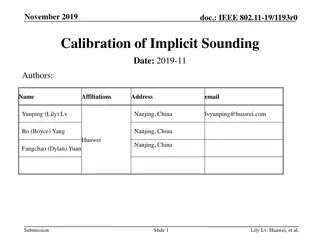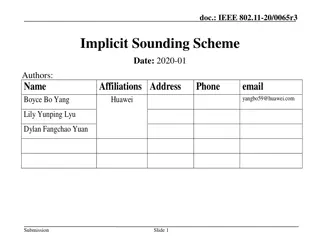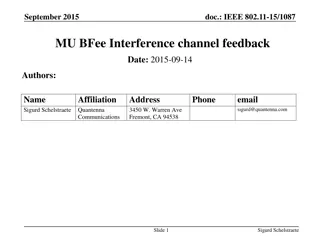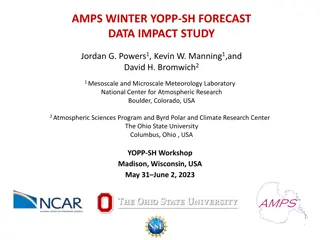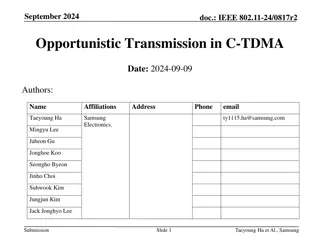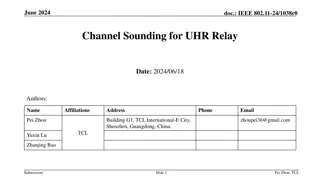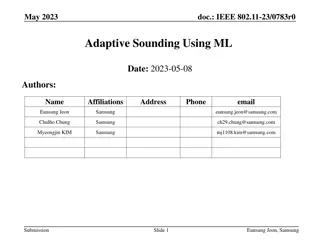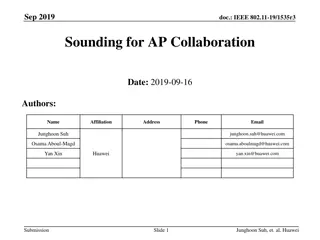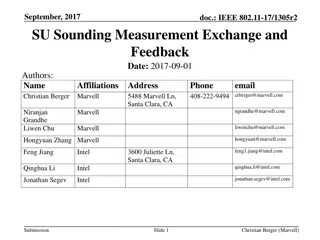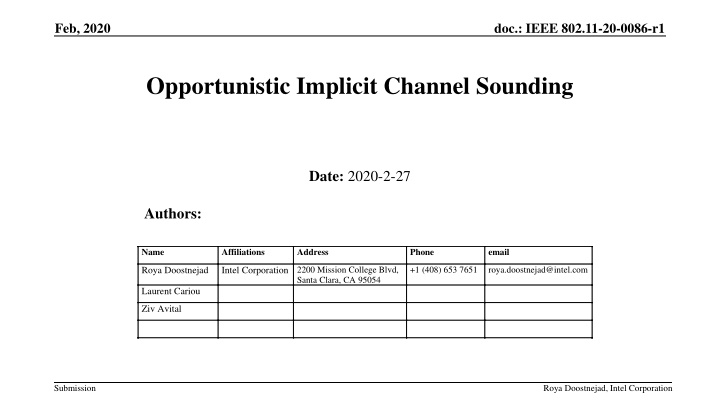
IEEE 802.11-20-0086-r1 Opportunistic Implicit Channel Sounding
Explore the concept of implicit channel sounding in IEEE 802.11-20-0086-r1, discussing benefits like lower overhead and latency. The document delves into trigger-based schemes for enabling implicit channel sounding in high traffic scenarios and leveraging uplink data traffic for channel information extraction.
Download Presentation

Please find below an Image/Link to download the presentation.
The content on the website is provided AS IS for your information and personal use only. It may not be sold, licensed, or shared on other websites without obtaining consent from the author. If you encounter any issues during the download, it is possible that the publisher has removed the file from their server.
You are allowed to download the files provided on this website for personal or commercial use, subject to the condition that they are used lawfully. All files are the property of their respective owners.
The content on the website is provided AS IS for your information and personal use only. It may not be sold, licensed, or shared on other websites without obtaining consent from the author.
E N D
Presentation Transcript
Feb, 2020 doc.: IEEE 802.11-20-0086-r1 Opportunistic Implicit Channel Sounding Date: 2020-2-27 Authors: Name Affiliations Address Phone email Intel Corporation 2200 Mission College Blvd, Santa Clara, CA 95054 +1 (408) 653 7651 roya.doostnejad@intel.com Roya Doostnejad Laurent Cariou Ziv Avital Submission Roya Doostnejad, Intel Corporation
Feb, 2020 doc.: IEEE 802.11-20-0086-r1 Introduction Explicit BF Feedback: o BF Feedback Overhead esp in case of higher number of antennas/higher number of STAs, and Multi-AP o Quantization/Compression impact o Channel aging/Feedback delay Implicit channel sounding may result: o Lower network overhead/ Less Latency as there is no BF feedback transmission. o No quantization/compression impact as BF weights are calculated directly from channel. o Efficient DL Multiuser (MU) BF Submission Roya Doostnejad, Intel Corporation
Feb, 2020 doc.: IEEE 802.11-20-0086-r1 Introduction In [1, 2, 3], feasibility of AP calibration to enable implicit sounding are discussed. In [4, 5], Precoding performance and network overhead analysis for implicit feedback are presented. In [4] a Trigger-based scheme was presented for enabling Implicit Channel Sounding in 802.11be. o AP transmits a trigger frame, to trigger one or multiple STAs, to send NDP in uplink. o The STAs are directed to be multiplexed in spatial/ frequency/ time domain. o Upon receiving NDP from the STA(s), AP will directly calculate BF weights and transmit data. In this contribution, opportunistic implicit sounding is discussedfor high traffic STAs. Uplink data traffic can be leveraged to extract channel information. Submission Roya Doostnejad, Intel Corporation
Feb, 2020 doc.: IEEE 802.11-20-0086-r1 Opportunistic Uplink Channel Sounding Option A - Trigger-based (TB) UL MU PPDU: o For the purpose of UL channel sounding, the AP indicates the number of HE-LTF symbols to be transmitted from each STA, in the Number Of HE-LTF Symbols And Mid-amble Periodicity (B23-25) subfield of the Common Info field of a Trigger frame (type 0, Basic). o HE-LTFs which are overlapping from multiple STAs in the same RU are multiplexed by Matrix-P. The spatial index for each STA is also defined in User Info field of the Trigger frame. o Even if the STA is transmitting single data stream, AP will set the number of HE-LTF symbols to the maximum number of STA s transmit antennas for UL MIMO channel sounding. o STA will send LTFs with full dimension (equal to number of STA s transmit antennas) Submission Roya Doostnejad, Intel Corporation
Feb, 2020 doc.: IEEE 802.11-20-0086-r1 Opportunistic Uplink Channel Sounding Option B - UL TB Block ACK transmission o Trigger frame type-2 is adopted in 802.11ax to trigger multi-user Block ACK responses from multiple STAs within an HE UL MU frame. o AP should configure relevant parameters such as LTF type, number of HE-LTF symbols as well as MU-MIMO LTF mode in Common Info subfield of the Trigger frame. o For full channel sounding on each STA, AP will set the number of HE-LTF symbols in Common Info field to the maximum number of antennas supported by all of the solicited STAs to enable full MIMO channel sounding. Submission Roya Doostnejad, Intel Corporation
Feb, 2020 doc.: IEEE 802.11-20-0086-r1 Opportunistic Uplink Channel Sounding Option C - High-Efficiency (HE) UL single-user (SU) PPDU: The AP which requires MIMO UL channel sounding, may indicate the number of required HE-LTF symbols in HE UL SU PPDU in Operating Mode (OM) Control field indication (OMI). o This can be done by defining a new subfield (e.g., NHE-LTF for Implicit Sounding ) in OM Control field. o The STA which receives the above OMI indicating implicit sounding with the required number of HE-LTF symbols, will set the number of HE-LTF symbols to the minimum of the number indicated in the NHE-LTF for Implicit Sounding subfield of the OM Control field, and number of STA s transmit antennas. o In HE SU PPDU, a 2-bits subfield is defined in HE-SIG-A to indicate NHE-LTF transmitted by the STA in the UL. For example, even if STA is transmitting single stream, if the NHE-LTF for Implicit Sounding subfield is set to 4 (in OMI), 4 HE-LTF symbols may be transmitted in HE SU. o Submission Roya Doostnejad, Intel Corporation
Feb, 2020 doc.: IEEE 802.11-20-0086-r1 Opportunistic Uplink Channel Sounding A common part in these options is that if the dimensionality of the channel is larger than the number of LTF symbols, used for channel estimation of the data, additional LTF symbols are included for full MIMO channel sounding. This is similar concept to extension spatial streams in 802.11n. For example if STA has two antennas but transmitting one SS, AP still sets the number of LTFs to be two for full MIMO channel sounding in UL. If STA applies spatial expansion (SE) for data, the same CDD as used for LTFs, should be applied to allow correct channel estimation for data detection. Submission Roya Doostnejad, Intel Corporation
Feb, 2020 doc.: IEEE 802.11-20-0086-r1 Conclusion Options for enabling opportunistic implicit channel sounding are discussed. For STAs with high traffic, uplink block ACK or UL MU PPDU /UL SU PPDU may be leveraged for opportunistic channel sounding in uplink. If the dimensionality of MIMO channel is larger than the number of HE-LTFs, AP should configure number of HE-LTF symbols for full MIMO channel sounding even if the STA is transmitting single stream. Full dimension LTF even if STA transmitting one spatial stream Submission Roya Doostnejad, Intel Corporation
Feb, 2020 doc.: IEEE 802.11-20-0086-r1 SP SP#1: Do you support that 11be spec defines Opportunistic Implicit Sounding where UL data traffic is leveraged to extract channel? TB UL MU PPDU, TB UL BACK, UL SU PPDU Y: N: Abstain: Submission Roya Doostnejad, Intel Corporation
Feb, 2020 doc.: IEEE 802.11-20-0086-r1 SP SP#2: Do you support that 11be spec defines Opportunistic Implicit Sounding by allowing AP to set number of LTFs for full MIMO channel Sounding? The number of LTFs may be higher than what is required for channel estimation Y: N: Abstain: Submission Roya Doostnejad, Intel Corporation
Feb, 2020 doc.: IEEE 802.11-20-0086-r1 References [1]: IEEE802.11-19/0767r1,Implicit Channel Sounding in IEEE 802.11 (Feasibility Study) [2]: IEEE802.11-19/1939r0, Calibration of Implicit Sounding [3]: IEEE 802.11-20/0080, Calibration for Implicit Feedback [4]: IEEE 802.11-19/0768r0, Implicit Channel Sounding in IEEE 802.11 [5]: IEEE802.11-19/1934r0, Precoding perf. using implicit channel estimation Submission Roya Doostnejad, Intel Corporation
Feb, 2020 doc.: IEEE 802.11-20-0086-r1 Back Up Submission Roya Doostnejad, Intel Corporation
Feb, 2020 doc.: IEEE 802.11-20-0086-r1 Example STA with 4 antennas transmitting 2 SS but 4 LTFs for full MIMO channel sounding CDD: [0 ns -400 ns -200 ns -600 ns] are applied for 4 LTFs SE for two SS (?1,?2) should follow: Submission Roya Doostnejad, Intel Corporation





